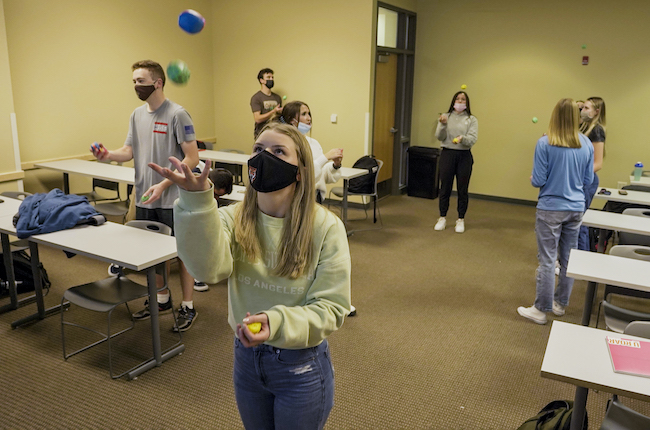ISU's Newest Class, ROAR 1199, Introduces Novel Idea to Teach Persistence
November 10, 2021

In ROAR 1199, ISU’s first-year experience course, students got a surprising challenge early in the semester. They were asked to learn to juggle.
“You wouldn’t expect your college teacher to tell you that you’ll be learning how to juggle,” said Kaylee Kaminsky, a ROAR 1199 student. “But, next thing you know, she brings a backpack full of juggling balls, asks you to grab three and start to practice.”
While juggling is not the most conventional learning approach, it’s being used to teach persistence, an important skill needed to navigate the college experience.
According to James DiSanza, the ROAR Course Coordinator and Chair of the department of Communication, Media and Persuasion, the idea came to him when he was developing a new unit on teaching how the brain learns.
“To demonstrate the importance of persistence, I needed an activity that would be fun, that students could do in class, that most wouldn’t be very good at, and that practice for 10 minutes each day would clearly demonstrate improvement and show how the brain learns and develops, as long as people stuck with it” DiSanza said.
The human brain is composed of 100 billion neurons communicating through electro-chemical signals that flow from axons at the end of one nerve cell to dendrites at the beginning of another. New learning is difficult and requires conscious concentration because the communication pathways between neurons are minimal and signals travel slowly.
As one practices new learning, dendrites reach out to make connections with axons and the neurons get used to firing together and do so with greater efficiency, speeding up response times with less conscious effort. What once took enormous concentration, soon becomes automatic as new neural connections are made. This is referred to as “neuroplasticity,” the ability to mold the brain through persistent practice.
“The problem for many students,” DiSanza said, “is they drop a class believing they aren’t good at something before those new neural connections are fully developed. Persistence is necessary for new learning to take hold. Juggling is a way we can demonstrate the pay-off to persistence.”
“We want them to pay attention to how they learn,” said Elise Barker, a ROAR 1199 instructor. “Most students have very little prior experience with juggling, so they were able to track their progress from that first rocky day in class all the way through successfully juggling three balls in succession. They got to experience neuroplasticity first-hand.”
Students appear to have picked up on why they are being asked to do it, and one has even pushed herself to continue the hobby specifically to challenge her brain.
“Learning is like creating a pathway in the woods,” said Jessica Salisbury, a freshman ROAR 1199 student. “However, when nobody regularly walks on the path, the woods turn it back into a crowded and bushy area that is not inviting to walk on. I did not want this to happen in my brain. In order to keep the juggling pathway alive, I thought it would be a great idea to buy some juggling balls of my own, which I did.”
Salisbury wasn’t the only student inspired to keep practicing outside of class.
“Even though we were not assigned to go home and practice with random objects in our house, a lot of us did, including myself,” said ROAR student, Aimee Harris. “If that is not persistence in learning, I don’t know what is.”
Beyond fulfilling a class objective, juggling has also become a bonding experience for these first year students.
“What really helped me succeed in juggling was connecting with my classmates,” said Emma Fitzgerald, ROAR student.
According to DiSanza, the fun (and early failure) involved in learning to juggle helped students laugh and develop connections with one another and their instructor, who also learned to juggle during class. Developing these connections gives them a better chance at succeeding in college.
ISU’s Fall 2020 Leaver Survey, which examines reasons why students drop out, found that 56 percent of respondents did not have a faculty or staff member that they could talk to or feel a connection with, and 21% of respondents did not have a friend at ISU.
The ROAR 1199 program is designed to increase the likelihood of students’ academic and social success at ISU, reducing dropout rates among first year students.
“Juggle time was my favorite part of the day,” said ROAR student, Abby Biorn.
“Mine too,” Barker agreed.
Categories:
